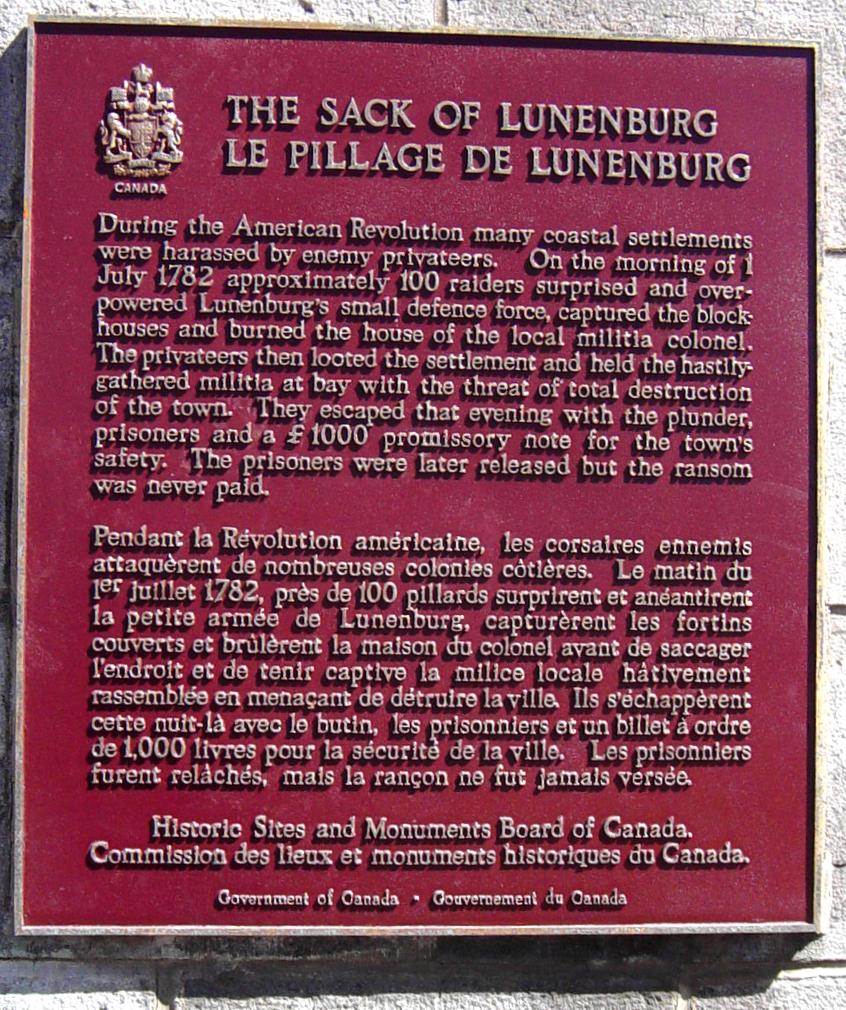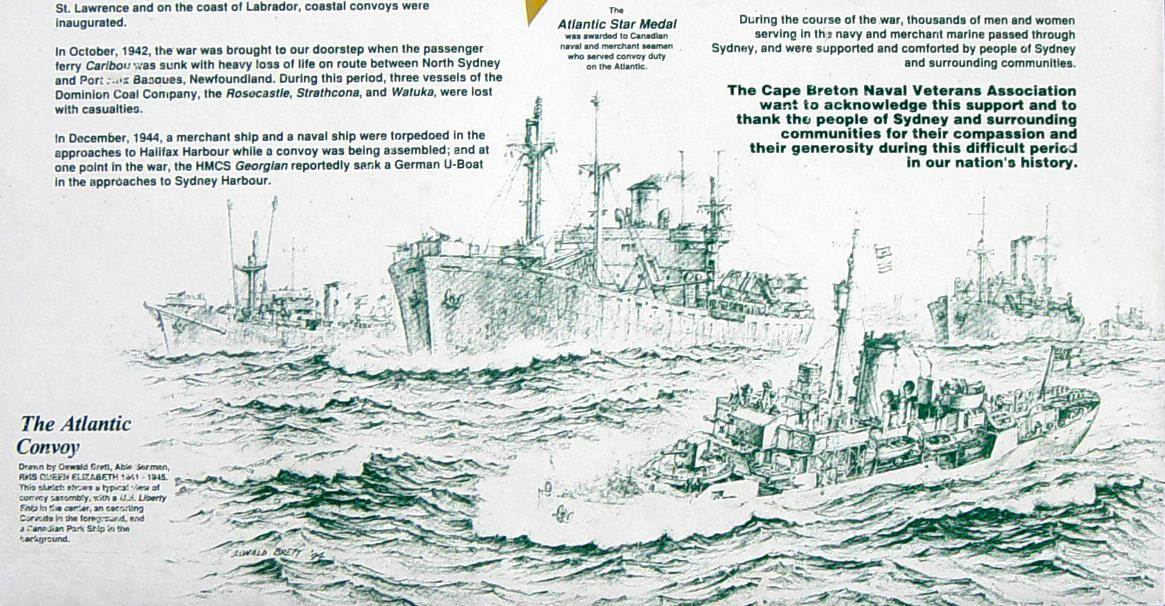
Sack of Lunenburg by American privateers
1 July 1782
sack – to plunder a city, town, etc.,
usually by the soldiers of a victorious army, or by pirates
plunder – to rob a place of goods, valuables, etc.,
by forcible means, especially as done in war
Photographs of Plaque
Lunenburg Lunenburg County Nova Scotia
Located at the intersection of Falkland Street with Victoria Road
GPS location: 44°22’37″N 64°19’10″W

Photographed on 4 April 2007

Looking northeast
Photographed on 10 July 2003
Also see: The other side of this monument
Sack of Lunenburg, 1 July 1782
http://www.gov.ns.ca/nsarm/virtual/lunenburg/archives.asp?ID=6
Privateers and the American Revolution
…It is estimated that 2,000 privateer commissions were issued (by the
rebelling colonies) and that between 250 and 400 privateer ships were
always functioning during the late 1770s. The smallest of the colonies,
Rhode Island, sent out fifty-seven privateer ships…
http://www.allsands.com/privateersameri_wq_gn.htm
American Maritime Documents, 1776-1860: Letter of Marque/Privateer Commission
…Letters of Marque were licenses granted by a monarch or government
to privately-owned vessels, enabling them under certain conditions to war
against the shipping of an enemy nation. The word marque, from the
French, was used in this sense to mean a pledge to seize or capture.
Vessels carrying these documents were popularly known as privateers…
During the American Revolution (1776-1783) the Continental Congress
adopted a printed form with blank spaces for the name of the vessel,
owners and master, and figures for tonnage, guns and crew. These blank
commissions, signed by the President of Congress, were sent out to the
United Colonies, who assumed primary responsibility for the regulation
and conduct of their own privateer fleets…
http://www.mysticseaport.org/library/initiative/
ImText.cfm?BibID=6405&ChapterId=23
Texas Privateers Texas State Library and Archives Commission
Because their activities were committed under the rule of law,
privateers were sometimes called “gentleman pirates.” Letters of
marque and reprisal have been issued since the thirteenth century.
The word “marque” comes from the French word for border, giving
the holder permission to cross the border; “reprisal” is used in the
original sense of “taking prizes.” The purpose of the letters was to
augment a nation’s navy, creating a force which could pillage the
enemy at no cost to public funds. The privateers had to bring their
prizes to an Admiralty Court so that the booty could be legally divided,
and there were heavy penalties for attacking the property of a neutral
state. Often, privateers were also authorized to take hostages,
who would be ransomed back to the enemy or held for leverage in a
prisoner exchange. When the American Revolution began, the
rebelling colonies could lay claim to only 31ships. The Continental
Congress commissioned more than 1600privateers, which captured
more than 2000enemy vessels and 16,000enemy combatants.
The privateers suffered heavy losses themselves, and at least 11,000
of them perished due to maltreatment as British prisoners of war…
During the American Civil War (1861-65), the Confederacy issued
99 letters of marque (the most famous Southern privateer being the
fictional Rhett Butler of Gone with the Wind)…
http://www.tsl.state.tx.us/exhibits/navy/privateers.html
Privateer
Privateer, in international law, is a term applied to a privately owned
armed vessel whose owners are commissioned by a belligerent nation
to carry on naval warfare. Such naval commissions or authorizations
are called letters of marque. Privateering is distinguished from piracy,
which is carried out without enlistment by a government. Privateering
was abolished by the Declaration of Paris of 1856, but the declaration
was not supported by the United States, Spain, Mexico, and Venezuela…
http://www.geocities.com/Athens/Styx/2188/privater.htm
Privateer’s Kit
Reproductions of all the forms you need to set out on the high
seas against the British. A letter of Marque authorized the captain
to capture British ships and sell the cargoes at public auction.
Not only did a captain need a Letter of Marque, he also had to post
a Privateer’s bond stating that he would not violate international law.
The captain also received a set of instructions from Congress, which
laid out all of the laws and rules that he must follow to be considered
a privateer and not a pirate…
http://www.sullivanpress.com/Revolution.htm
Regulating the New Privateers of the 21st Century by William R. Casto
Rutgers Law Journal v37 i3 Spring 2006
When our Founders licensed privateers to perform military duties
at sea where there was no functioning government, they created a
comprehensive regulatory scheme to regulate the privateers.
A comparable scheme is necessary to regulate the new privateers
of the twenty-first century. The conduct of PMFs who are employed
by the United States to act for and to represent the United States
should be regulated by the United States. Extending American law
overseas to regulate conduct in foreign lands is not inconsistent with
the ancient principle of territoriality. The power of government to
regulate the actions of its citizens and agents has always been
viewed as an appropriate exception to the principle of territoriality.
The exception held true when the United States regulated its
privateers some two centuries ago, and it is equally applicable in
respect of the new privateers of the twenty-first century…
http://org.law.rutgers.edu/publications/lawjournal/37_3/casto2.pdf




